The Impact of Technology on Kids Today
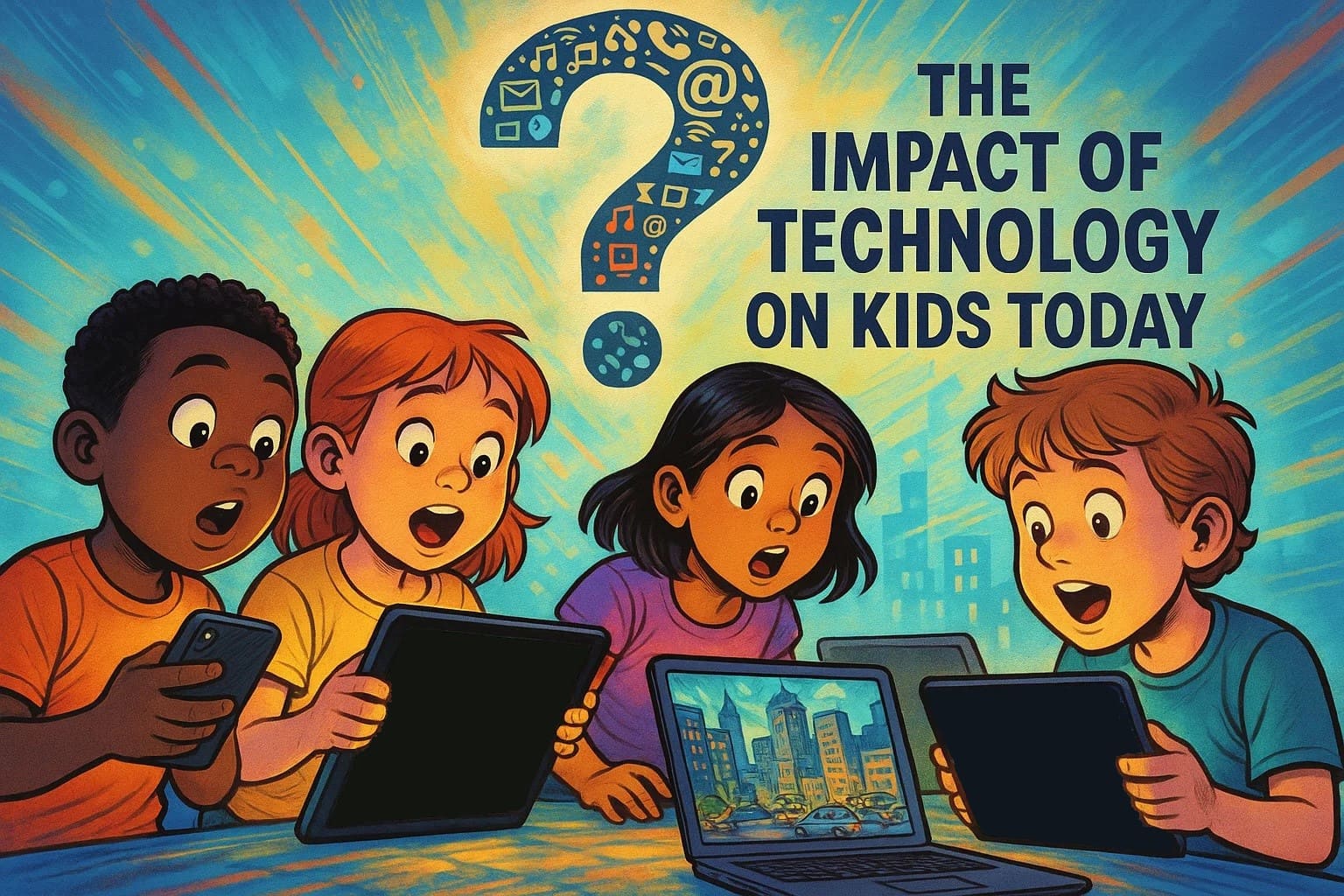
In today’s digital landscape, understanding how technology affects children has become crucial for parents, educators, and caregivers. While digital technology offers unprecedented learning opportunities, it also presents unique challenges that require careful navigation.
Children and Technology

A look at how technology is woven into the lives of children from a young age.
Young Children and Screens 📱
Young children are encountering screens at increasingly early ages, with many toddlers using tablets and smartphones before they can walk confidently. The American Academy of Pediatrics recommends limited screen time for children ages 2 to 5, suggesting no more than one hour of high-quality programming daily.
Early exposure to digital technology can influence brain development in significant ways. When children use technology during critical developmental periods, it may affect their attention spans, language acquisition, and ability to engage in face-to-face interaction. However, educational content designed specifically for younger children can support early learning when used appropriately.
Parents should consider that every interaction with technology becomes a learning experience. The key lies in ensuring that screen-based activities complement rather than replace essential developmental activities like physical play, reading, and social interaction. Technology provides a new medium for learning, but it should not be the only one.
Toddlers and Early Learning 🧸
For toddlers, technology presents both opportunities and challenges. Educational apps and programs can introduce basic concepts like colors, numbers, and letters, potentially supporting early childhood education goals. Research from Paediatrics & Child Health indicates that interactive digital content children engage with may help them learn more effectively than passive viewing.
However, toddlers benefit from technology most when it supplements, not replaces, hands-on experiences that engage multiple senses. The Child Mind Institute emphasizes that children ages 6 and under learn best through direct manipulation of their environment.
When toddlers do engage with technology, co-viewing with parents or caregivers enhances the learning experience. This shared interaction helps kids make connections between digital content and real-world concepts while maintaining the social element crucial for healthy development.
Every Child’s Digital World 🌍
Today’s children are growing up as digital natives, naturally adapting to technological environments that previous generations find challenging. This familiarity with digital technology can provide advantages in future careers and educational pursuits.
However, every child responds differently to technology. Some may thrive with educational technology tools, while others may struggle with self-regulation or become overstimulated by digital content. Individual differences in temperament, attention span, and learning style all influence how children interact with technology.
Understanding each child’s unique relationship with technology helps parents and educators make informed decisions about appropriate use. Regular observation and assessment can reveal whether technology use is supporting or hindering a child’s overall development.
Screen Time
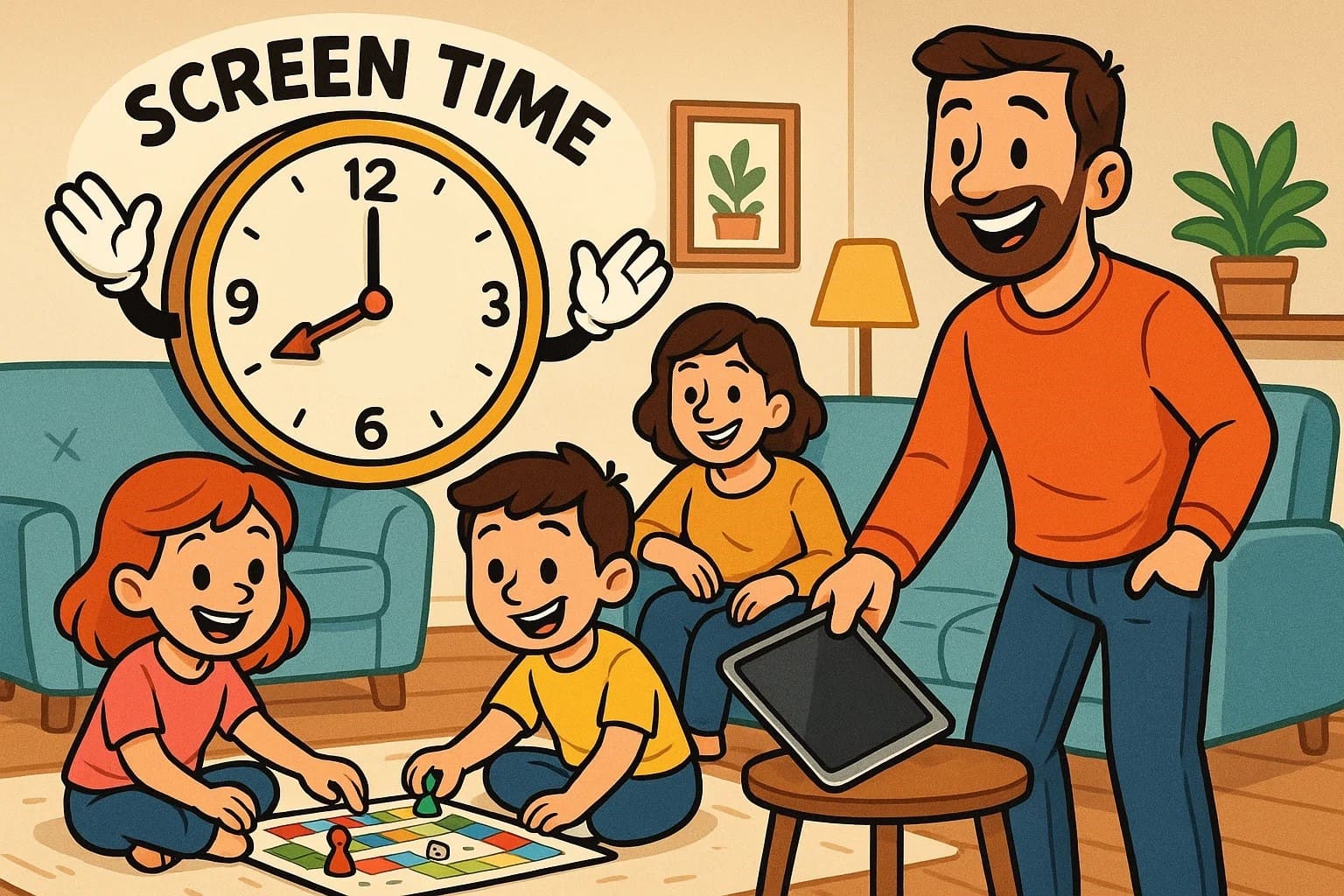
Guidelines and considerations for managing a child’s digital usage.
Managing Screen Time ⏰
Effective screen time management requires establishing clear boundaries and consistent routines. The American Academy of Pediatrics provides age-specific guidelines that can serve as starting points for family decisions. Give children clear expectations about when and where they can use screens.
| Age Group | Recommended Screen Time | Notes |
| Under 18 months | Avoid screens (except video chatting) | Focus on real-world exploration |
| 18-24 months | Watch together with parent | Choose high-quality programming |
| 2-5 years | 1 hour weekdays, up to 3 hours weekends | Prioritize educational content |
| 6+ years | Consistent limits that don’t interfere with sleep, physical activity, or other essential activities | Individual family decisions |
Setting limits involves more than just time restrictions. Parents should consider the quality of content, timing of screen use, and how technology use affects other important activities. Creating screen-free zones in bedrooms and during meal times helps maintain healthy boundaries.
Successful screen time management often involves involving children in creating family media plans. When kids understand the reasoning behind limits and participate in setting them, they’re more likely to cooperate with established boundaries.
The Effects of Too Much Screen Time 📺
Excessive screen time can lead to various negative effects on a child’s development. Physical health concerns include eye strain, poor posture, and reduced physical activity levels. Mental health issues may emerge when screen time replaces sleep, social interaction, or physical exercise.
Kids who use screens excessively may experience:
- Delayed language development, particularly in younger children
- Difficulty with attention and focus in non-digital environments
- Reduced time for creative play and imagination
- Sleep disruptions, especially when screens are used before bedtime
- Increased risk of anxiety and behavioral problems
The Child Mind Institute notes that these effects are often dose-dependent, meaning that moderate, appropriate use is less likely to cause problems than excessive use. The key lies in maintaining balance and ensuring that screen time doesn’t crowd out other essential childhood activities. Playing video games, for example, can be a great way to unwind, but not at the expense of other activities.
Research from Paediatrics & Child Health suggests that the content and context of screen time matter as much as duration. Educational content used interactively with parents may have different effects than passive consumption of entertainment media.
Balancing Screen Time and Physical Activities ⚽
Physical activities remain crucial for healthy child development, supporting motor skills, coordination, and overall physical health. Technology use should complement rather than replace active play, sports, and outdoor exploration.
Creative approaches to balancing screen time and physical activities include:
- Movement-based apps and games that encourage physical activity
- Outdoor exploration apps that guide nature walks and scavenger hunts
- Dance and exercise videos that combine screen time with movement
- Family challenges that alternate between digital and physical activities
Many families find success with earning systems where physical activity or outdoor play “earns” screen time privileges. This approach helps kids understand the importance of balance while maintaining motivation for both types of activities.
Technology can also support physical activities through fitness trackers designed for kids, apps that teach sports techniques, or programs that gamify exercise routines.
Technology on Children
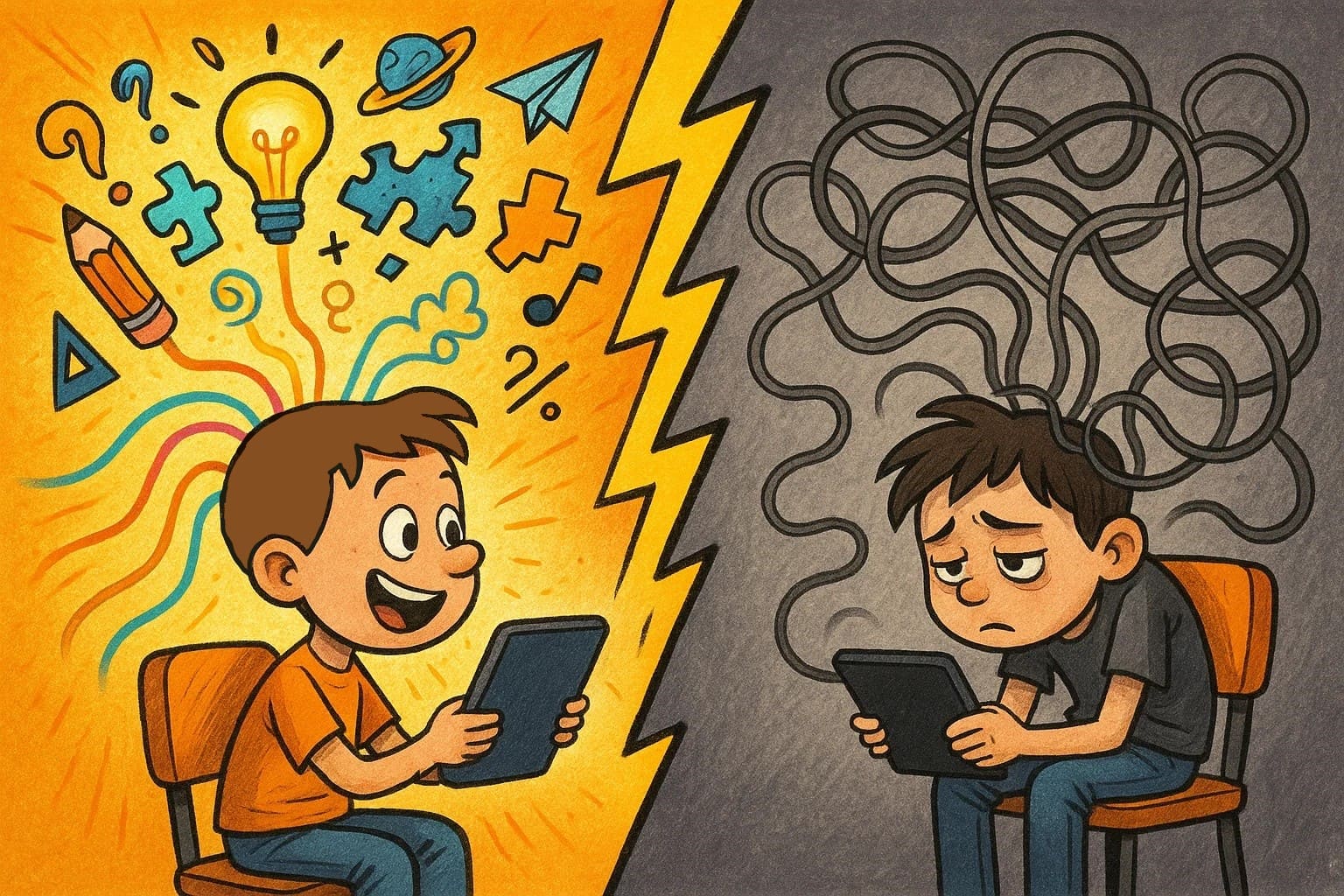
The various ways digital tools can either help or hinder a child’s development.
Benefits of Technology ✨
When used appropriately, technology provides numerous benefits for children’s development and learning. Educational technology can provide personalized learning experiences, adapting to individual learning styles and paces. Interactive content often engages children more effectively than traditional passive learning methods.
Key benefits include:
- Enhanced Learning Opportunities: Digital platforms offer access to vast educational resources, virtual field trips, and interactive simulations that would be impossible in traditional settings.
- Skill Development: Technology helps kids develop digital literacy skills essential for future academic and career success. Problem-solving skills are enhanced through educational games and coding activities.
- Accessibility: For children with learning differences or disabilities, assistive technology can provide crucial support and accommodation.
- Global Connections: Technology allows children to connect with peers worldwide, fostering cultural awareness and global perspectives.
- Creative Expression: Digital art tools, music production software, and video creation platforms offer new avenues for creative expression and artistic development.
Negative Effects ⚠️
Despite its benefits, technology use can also present challenges for children’s learning and development. Understanding these potential negative effects helps parents and educators make informed decisions about technology integration. Children may struggle with certain aspects of tech.
Social Development Concerns: Excessive technology use may reduce face-to-face interaction opportunities, potentially impacting the development of social skills and emotional intelligence. Children may struggle with reading non-verbal cues or engaging in spontaneous social interactions.
Attention and Focus Issues: rapid-fire digital content may contribute to attention difficulties, though the relationship between technology use and conditions like ADHD remains complex.
Sleep Disruption: The blue light emitted by screens can interfere with natural sleep patterns, particularly when devices are used close to bedtime. Poor sleep quality can affect learning, behavior, and physical health.
Physical Health Impacts: Extended screen time often involves sedentary behavior, potentially contributing to obesity and related health issues. Poor posture during device use can lead to neck and back problems.
Cyberbullying and Online Safety: As older children use technology more independently, they may encounter cyberbullying, inappropriate content, or online predators. These risks require active parent involvement and education.
The Use of Technology for Learning 📚
Educational technology has revolutionized how children learn, offering interactive and engaging experiences that can enhance traditional teaching methods. When implemented thoughtfully, technology can support diverse learning styles and provide immediate feedback to learners.
Personalized Learning: Adaptive learning platforms adjust difficulty levels based on individual progress, ensuring appropriate challenge levels for each child. This personalization can help prevent both boredom and frustration.
Interactive Content: Educational games and simulations make abstract concepts concrete and memorable. For example, virtual science experiments allow children to explore concepts safely and repeatedly.
Immediate Feedback: Digital learning tools often provide instant feedback, helping children understand mistakes and correct them immediately. This rapid feedback loop can accelerate learning and build confidence.
Multimedia Learning: Technology combines text, images, audio, and video to create rich learning experiences that appeal to different learning preferences and help reinforce concepts through multiple sensory channels.
The most effective educational technology use involves active engagement rather than passive consumption, with children creating, problem-solving, and collaborating rather than simply consuming content.
The Impact of Technology
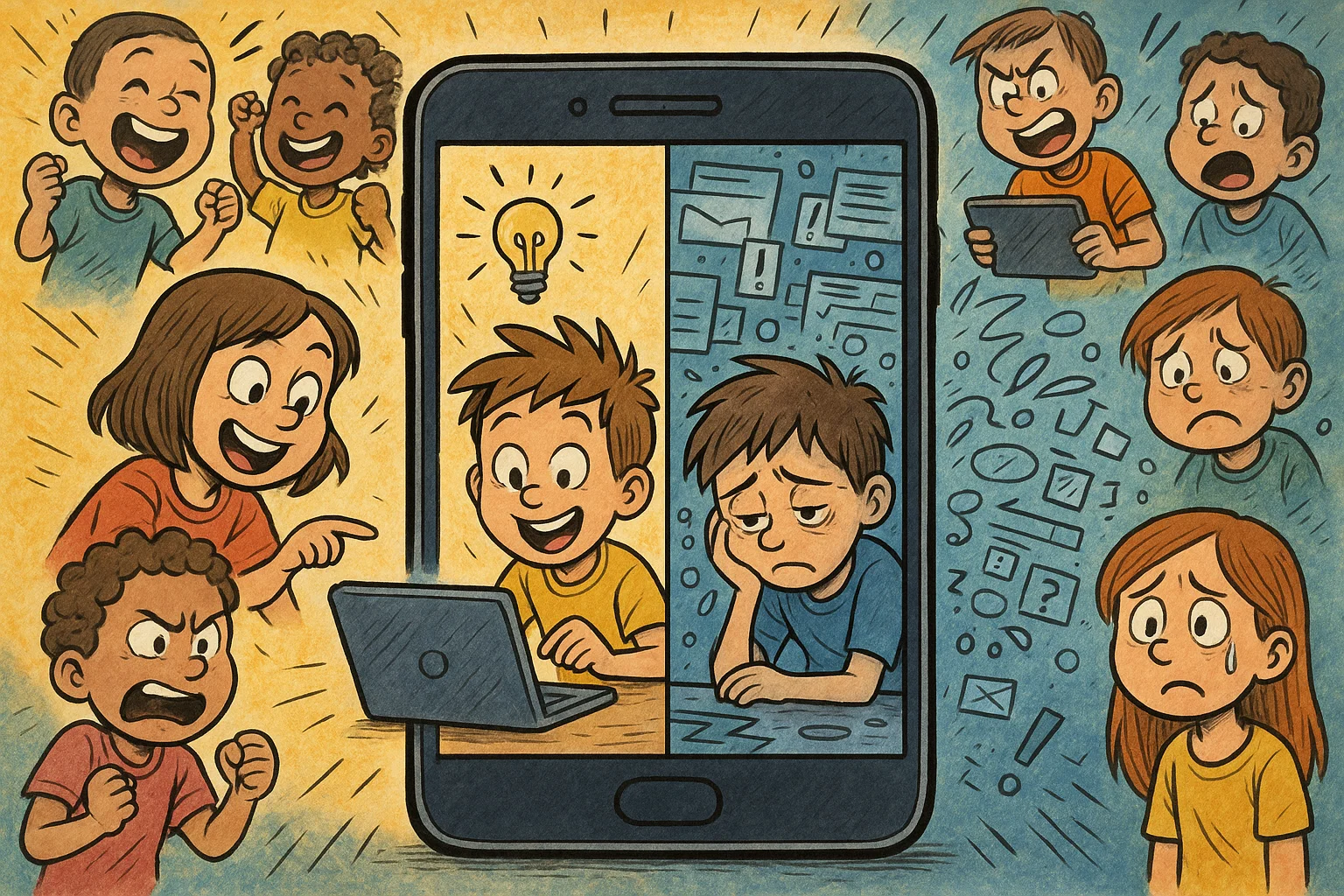
Exploring the deeper effects of technology on social, emotional, and physical well-being.
Technology and Social Interaction 👥
Technology’s impact on social interaction presents a complex picture with both positive and negative implications. While digital communication tools can help children stay in touch with distant family members and friends, they may also reduce opportunities for developing face-to-face social skills.
Positive Social Impacts:
- Video calling allows meaningful connections with extended family
- Collaborative online games can foster teamwork skills
- Social platforms designed for children provide safe spaces for interaction
- Technology can help shy children find their voice and feel more comfortable initiating social contact
Potential Concerns:
- Reduced practice with non-verbal communication skills
- Difficulty reading emotional cues in face-to-face situations
- Risk of social anxiety when technology becomes the preferred communication method
- Potential for online conflicts or cyberbullying
Research from the Child Mind Institute suggests that the quality of children’s online interactions matters more than quantity. Meaningful digital connections can supplement but shouldn’t replace in-person relationships.
Impact on Physical Activities 🏃♀️
The relationship between technology use and physical activity levels has become a significant concern for child development experts. While technology can sometimes motivate physical activity through fitness apps and active games, excessive screen time often correlates with reduced physical activity.
Physical Activity Challenges:
- Sedentary screen time can contribute to childhood obesity
- Reduced outdoor play may impact motor skill development
- Less exposure to natural environments affects overall well-being
- Competition between screen time and sports or active play
Technology Solutions:
- Active video games that require physical movement
- Fitness trackers that gamify physical activity
- Apps that encourage outdoor exploration and nature connection
- Virtual coaching for sports skills development
Successful integration involves using technology to enhance rather than replace physical activities, encouraging children to see digital tools as supplements to active lifestyles.
How Children Learn with Technology 🎯
Technology fundamentally changes how children process and retain information. Understanding these changes helps kids learn more effectively.
Learning Process Changes:
- Faster information processing but potentially reduced deep thinking
- Preference for visual and interactive content over text-based learning
- Expectation of immediate answers and feedback
- Multitasking abilities but possible attention fragmentation
Optimizing Technology for Learning:
- Scaffolded Learning: Gradually increase complexity and independence
- Active Participation: Choose tools requiring interaction over passive consumption
- Real-World Connections: Link digital learning to physical world experiences
- Reflection Time: Include periods for processing and consolidating learning
Effective technology integration supports rather than replaces fundamental learning processes like critical thinking, problem-solving, and creative expression.
Use Technology
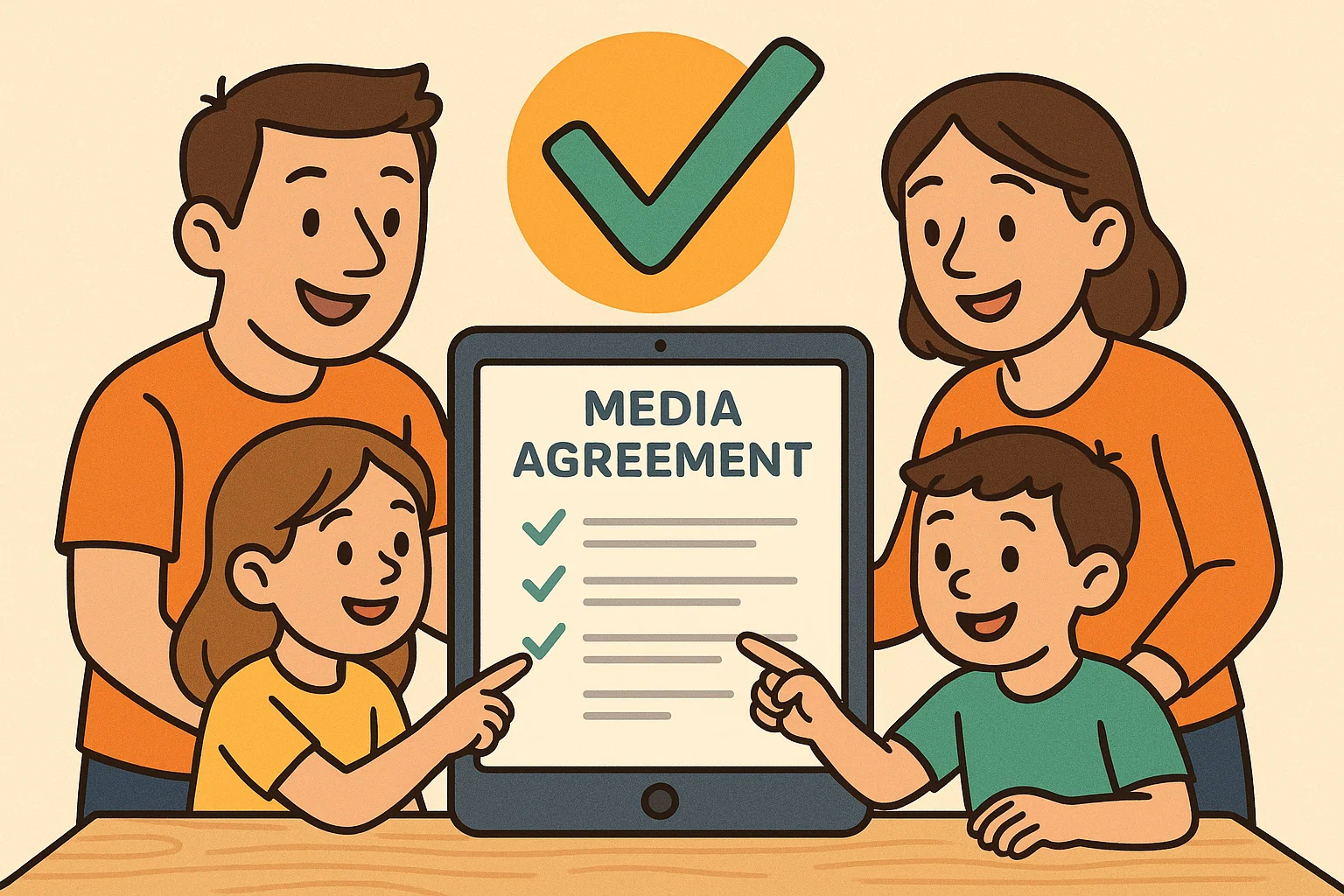
Practical advice for parents and educators on navigating the digital world.
How to Use Technology Safely 🛡️
Ensuring children to use technology safely requires proactive planning, ongoing supervision, and age-appropriate education about digital citizenship. Safety considerations extend beyond content filtering to include teaching children how to navigate digital environments responsibly.
Essential Safety Measures: Technical Safeguards:
- Install reputable parental control software
- Use family-friendly search engines and browsers
- Enable safe modes on video platforms
- Regularly review and update privacy settings
Educational Approaches:
- Teach children to recognize and report inappropriate content
- Discuss online stranger danger and appropriate sharing
- Model respectful digital communication
- Establish clear consequences for inappropriate technology use
Ongoing Supervision:
- Keep devices in common areas, not bedrooms
- Regularly check Browse history and app usage
- Maintain open communication about online experiences
- Give children a sense of trust while also staying involved in their digital activities.
The goal is gradually building children’s capacity for independent, responsible technology use while maintaining appropriate oversight for their developmental stage.
Guiding Children’s Use of Technology 🗺️
Effective guidance helps children develop healthy relationships with technology while maximizing its benefits for learning and development. This involves active involvement rather than simply setting rules and hoping for compliance.
Age-Appropriate Guidance Strategies: Ages 2-5:
- Co-view all content with children
- Choose educational programming with clear learning objectives
- Limit use to specific times and locations
- Focus on interactive rather than passive content
Ages 6-9:
- Establish clear usage schedules and stick to them
- Introduce basic digital citizenship concepts
- Begin teaching evaluation of online information
- Monitor content while allowing some independence
Ages 10+:
- Involve children in creating family technology agreements
- Discuss digital footprints and online reputation
- Address cyberbullying prevention and response
- Encourage critical thinking about media messages
Successful guidance involves regular family discussions about technology use, challenges, and successes, treating digital literacy as an ongoing learning process.
Positive Use of Technology 🌟
Maximizing technology’s positive impact requires intentional selection and use of digital tools that align with children’s developmental needs and family values. This involves moving beyond limiting screen time to actively choosing enriching digital experiences.
Characteristics of Positive Technology Use:
- Educational Value: Content teaches new concepts or skills
- Interactive Engagement: Kids engage actively rather than passively consume
- Social Connection: Technology facilitates meaningful relationships
- Creative Expression: Tools enable artistic or creative output
- Real-World Application: Digital learning connects to offline experiences
Examples of Enriching Technology Activities:
- Coding Games: Develop logical thinking and problem-solving skills
- Digital Art Creation: Foster creativity and artistic expression
- Virtual Museum Tours: Expand cultural and historical knowledge
- Video Calls with Family: Maintain important relationships
- Educational Podcasts: Support listening skills and knowledge acquisition
The most beneficial technology use often involves adult participation or follow-up, helping children process and apply what they’ve learned through digital experiences.
FAQ
How much screen time is appropriate for different age groups?
The American Academy of Pediatrics recommends avoiding screens for children under 18 months (except video chatting), limiting 18-24 month olds to high-quality content viewed with parents, and restricting 2-5 year olds to one hour of educational content on weekdays. For children 6 and older, consistent limits should ensure technology doesn’t interfere with sleep, physical activity, and other essential activities.
Can educational screen time replace traditional learning activities?
Educational technology should supplement, not replace, traditional learning experiences. Children benefit most from a balanced approach that includes hands-on activities, social interaction, physical play, and digital learning. The Child Mind Institute emphasizes that young children learn best through direct manipulation of their environment and face-to-face interaction.
What are the warning signs that a child is using too much technology?
Warning signs include difficulty sleeping, declining academic performance, reduced interest in offline activities, increased irritability when technology is unavailable, physical complaints like headaches or eye strain, and decreased social interaction. If these symptoms persist, consider reducing screen time and consulting with healthcare providers.
How can parents help children develop healthy relationships with technology?
Parents can model appropriate technology use, establish clear boundaries, engage with children about their digital experiences, and prioritize high-quality educational content. Creating technology-free zones and times, encouraging physical activity, and maintaining open communication about online experiences all contribute to healthy technology relationships. It’s important that parents see technology as a tool that needs to be managed, not simply avoided.
At what age should children start learning about online safety?
Online safety education should begin as soon as children start using connected devices, typically around ages 3-5 with basic concepts about appropriate and inappropriate content. Formal digital citizenship education becomes more important as children gain independence with technology, usually around ages 6-8, with ongoing discussions adapting to their developmental needs and increased digital autonomy.
